MBA402 - Risk Assessment Report: Trading.com Case Study
VerifiedAdded on 2023/03/23
|12
|2826
|58
Report
AI Summary
This report provides a detailed risk assessment of Trading.com, a fictional company, based on the 'How Risky is Your Company?' framework. It examines pressure points related to growth (performance pressure, expansion rate, employee inexperience), culture (entrepreneurial risk-taking rewards, resistance to bad news, internal competition), and information management (transaction complexity, diagnostic performance gaps, decentralized decision-making). The assessment uses a risk exposure calculator to quantify the overall risk. The report concludes that managing these risk factors is crucial for Trading.com's sustainable growth and success in a competitive market, emphasizing the importance of addressing challenges and threats to improve functional quality and leverage opportunities.
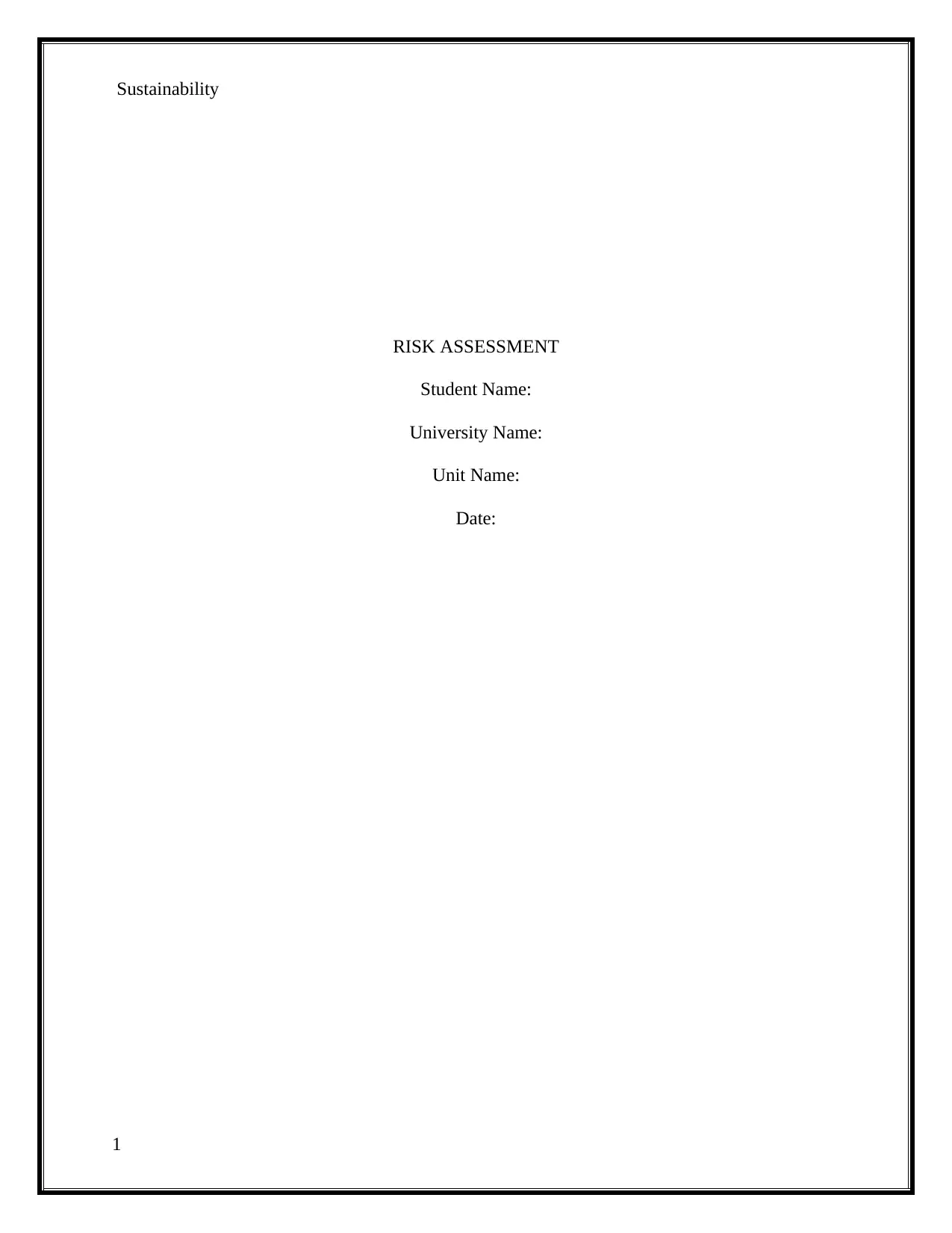
Sustainability
RISK ASSESSMENT
Student Name:
University Name:
Unit Name:
Date:
1
RISK ASSESSMENT
Student Name:
University Name:
Unit Name:
Date:
1
Paraphrase This Document
Need a fresh take? Get an instant paraphrase of this document with our AI Paraphraser
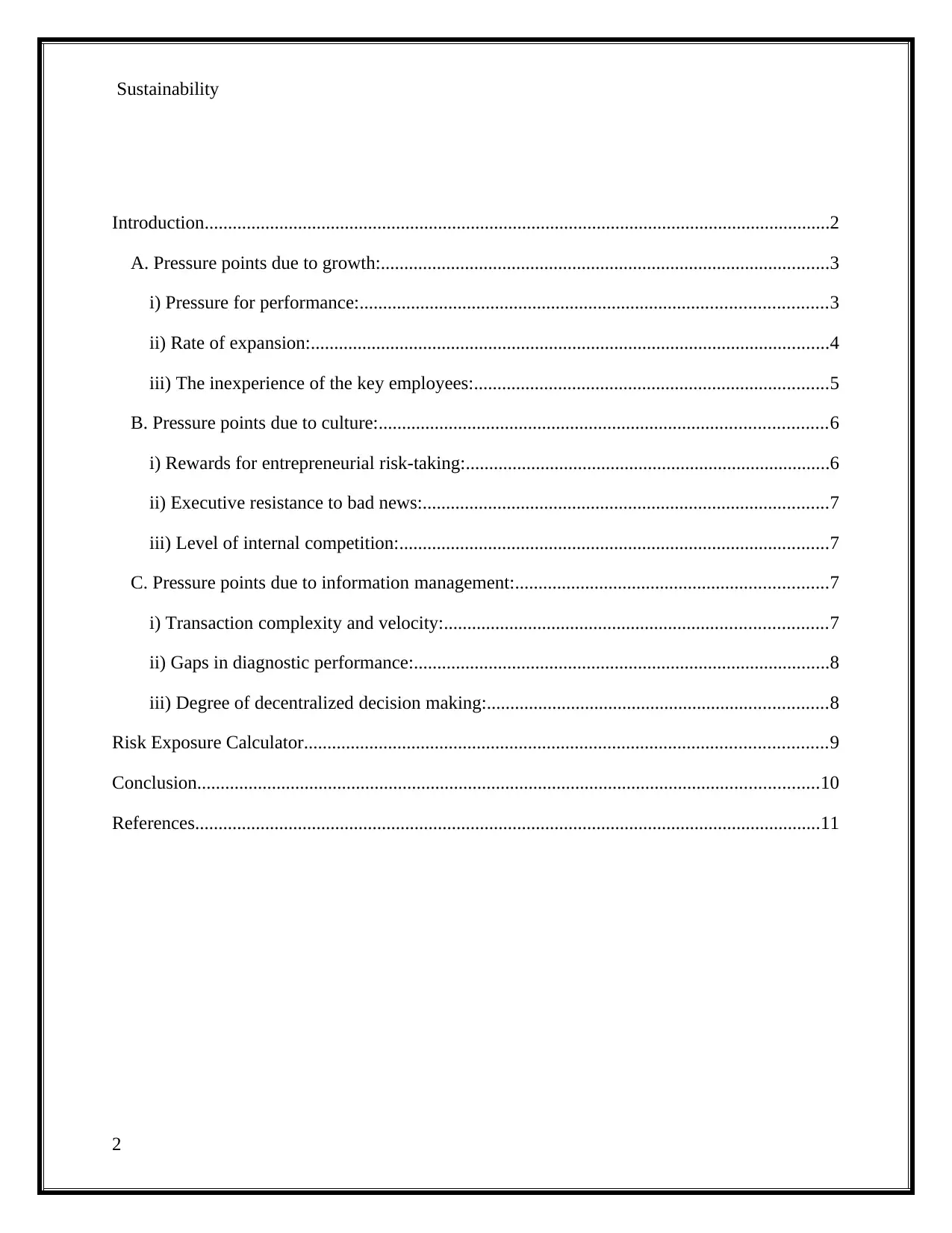
Sustainability
Introduction......................................................................................................................................2
A. Pressure points due to growth:................................................................................................3
i) Pressure for performance:....................................................................................................3
ii) Rate of expansion:...............................................................................................................4
iii) The inexperience of the key employees:............................................................................5
B. Pressure points due to culture:................................................................................................6
i) Rewards for entrepreneurial risk-taking:..............................................................................6
ii) Executive resistance to bad news:.......................................................................................7
iii) Level of internal competition:............................................................................................7
C. Pressure points due to information management:...................................................................7
i) Transaction complexity and velocity:..................................................................................7
ii) Gaps in diagnostic performance:.........................................................................................8
iii) Degree of decentralized decision making:.........................................................................8
Risk Exposure Calculator................................................................................................................9
Conclusion.....................................................................................................................................10
References......................................................................................................................................11
2
Introduction......................................................................................................................................2
A. Pressure points due to growth:................................................................................................3
i) Pressure for performance:....................................................................................................3
ii) Rate of expansion:...............................................................................................................4
iii) The inexperience of the key employees:............................................................................5
B. Pressure points due to culture:................................................................................................6
i) Rewards for entrepreneurial risk-taking:..............................................................................6
ii) Executive resistance to bad news:.......................................................................................7
iii) Level of internal competition:............................................................................................7
C. Pressure points due to information management:...................................................................7
i) Transaction complexity and velocity:..................................................................................7
ii) Gaps in diagnostic performance:.........................................................................................8
iii) Degree of decentralized decision making:.........................................................................8
Risk Exposure Calculator................................................................................................................9
Conclusion.....................................................................................................................................10
References......................................................................................................................................11
2
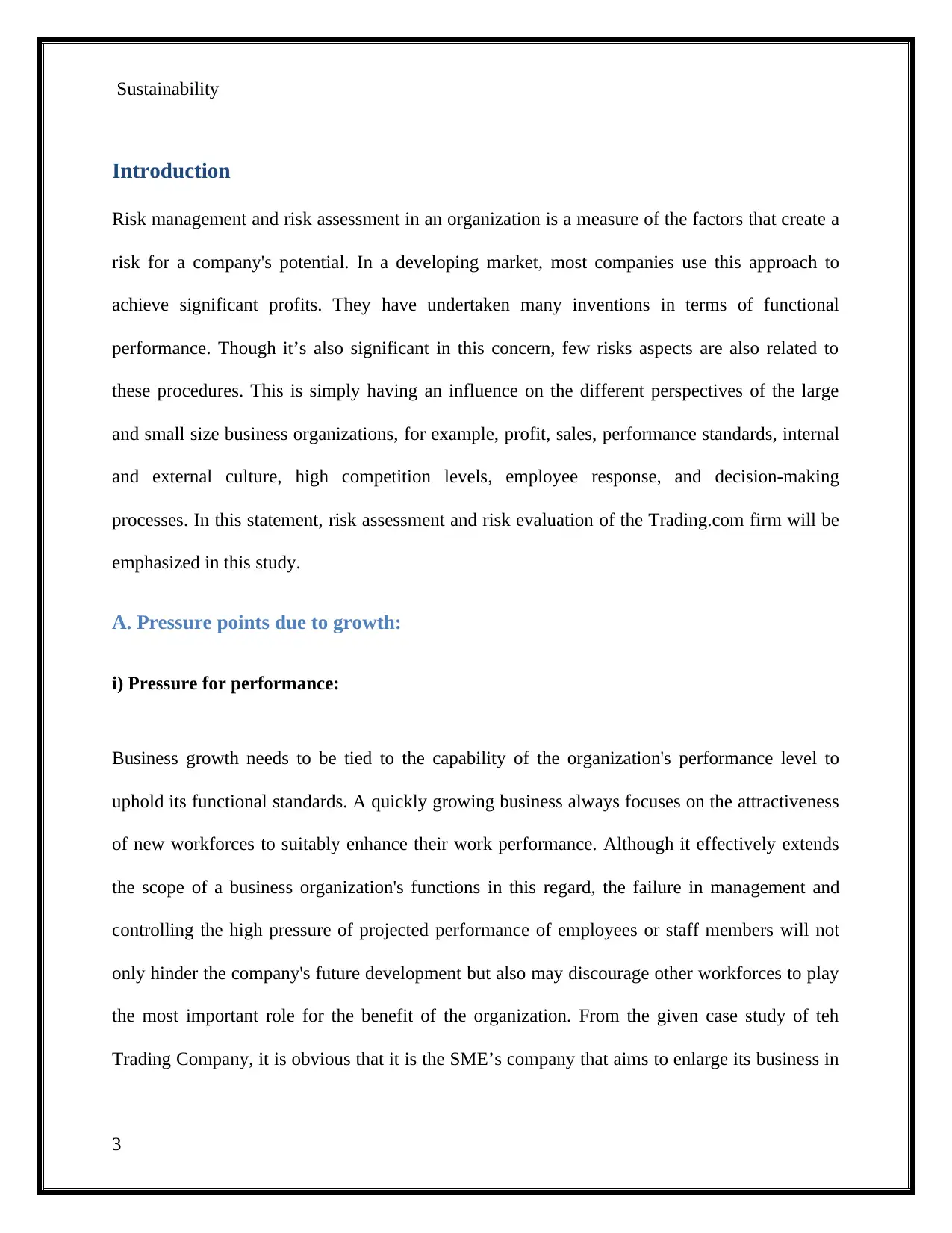
Sustainability
Introduction
Risk management and risk assessment in an organization is a measure of the factors that create a
risk for a company's potential. In a developing market, most companies use this approach to
achieve significant profits. They have undertaken many inventions in terms of functional
performance. Though it’s also significant in this concern, few risks aspects are also related to
these procedures. This is simply having an influence on the different perspectives of the large
and small size business organizations, for example, profit, sales, performance standards, internal
and external culture, high competition levels, employee response, and decision-making
processes. In this statement, risk assessment and risk evaluation of the Trading.com firm will be
emphasized in this study.
A. Pressure points due to growth:
i) Pressure for performance:
Business growth needs to be tied to the capability of the organization's performance level to
uphold its functional standards. A quickly growing business always focuses on the attractiveness
of new workforces to suitably enhance their work performance. Although it effectively extends
the scope of a business organization's functions in this regard, the failure in management and
controlling the high pressure of projected performance of employees or staff members will not
only hinder the company's future development but also may discourage other workforces to play
the most important role for the benefit of the organization. From the given case study of teh
Trading Company, it is obvious that it is the SME’s company that aims to enlarge its business in
3
Introduction
Risk management and risk assessment in an organization is a measure of the factors that create a
risk for a company's potential. In a developing market, most companies use this approach to
achieve significant profits. They have undertaken many inventions in terms of functional
performance. Though it’s also significant in this concern, few risks aspects are also related to
these procedures. This is simply having an influence on the different perspectives of the large
and small size business organizations, for example, profit, sales, performance standards, internal
and external culture, high competition levels, employee response, and decision-making
processes. In this statement, risk assessment and risk evaluation of the Trading.com firm will be
emphasized in this study.
A. Pressure points due to growth:
i) Pressure for performance:
Business growth needs to be tied to the capability of the organization's performance level to
uphold its functional standards. A quickly growing business always focuses on the attractiveness
of new workforces to suitably enhance their work performance. Although it effectively extends
the scope of a business organization's functions in this regard, the failure in management and
controlling the high pressure of projected performance of employees or staff members will not
only hinder the company's future development but also may discourage other workforces to play
the most important role for the benefit of the organization. From the given case study of teh
Trading Company, it is obvious that it is the SME’s company that aims to enlarge its business in
3
⊘ This is a preview!⊘
Do you want full access?
Subscribe today to unlock all pages.

Trusted by 1+ million students worldwide
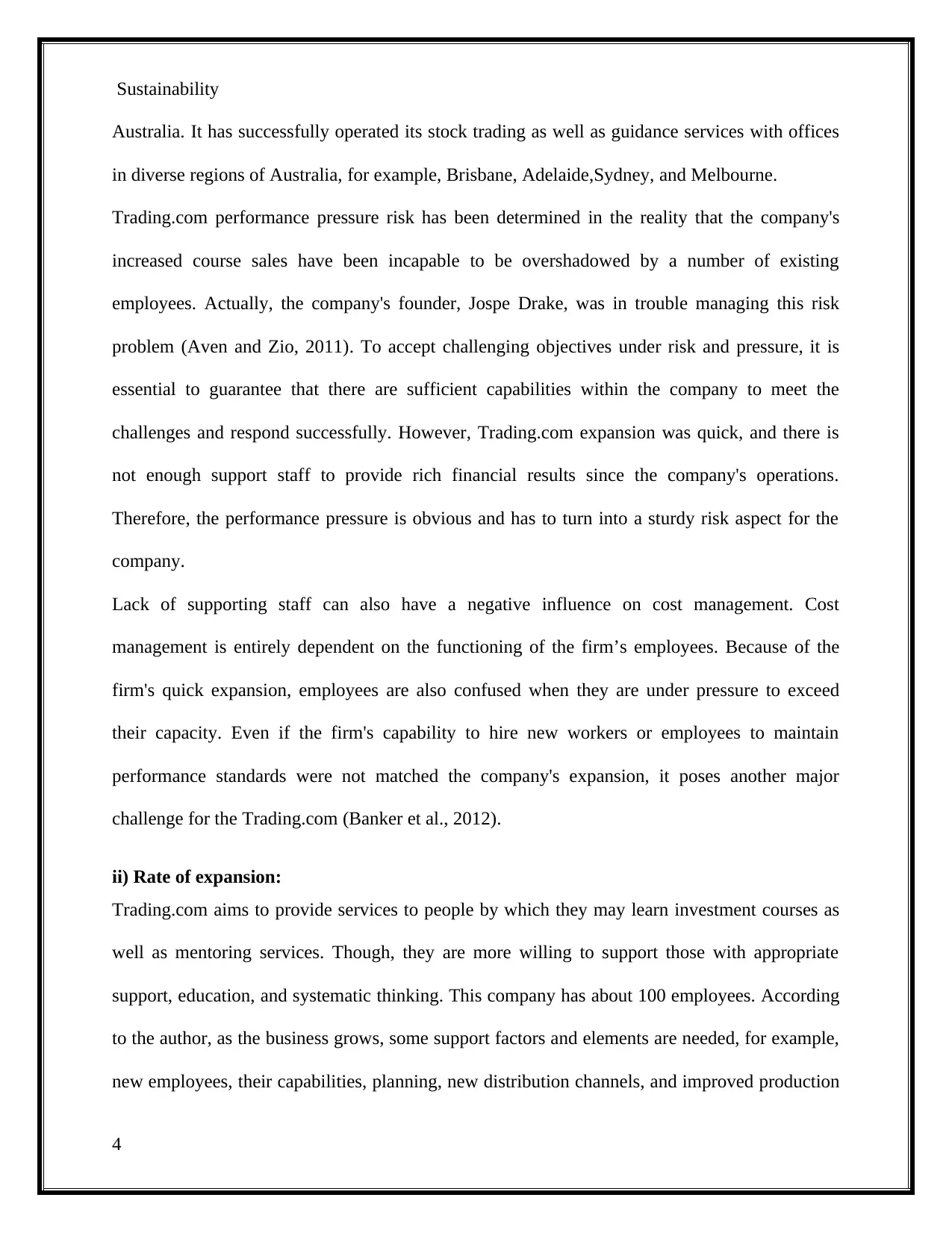
Sustainability
Australia. It has successfully operated its stock trading as well as guidance services with offices
in diverse regions of Australia, for example, Brisbane, Adelaide,Sydney, and Melbourne.
Trading.com performance pressure risk has been determined in the reality that the company's
increased course sales have been incapable to be overshadowed by a number of existing
employees. Actually, the company's founder, Jospe Drake, was in trouble managing this risk
problem (Aven and Zio, 2011). To accept challenging objectives under risk and pressure, it is
essential to guarantee that there are sufficient capabilities within the company to meet the
challenges and respond successfully. However, Trading.com expansion was quick, and there is
not enough support staff to provide rich financial results since the company's operations.
Therefore, the performance pressure is obvious and has to turn into a sturdy risk aspect for the
company.
Lack of supporting staff can also have a negative influence on cost management. Cost
management is entirely dependent on the functioning of the firm’s employees. Because of the
firm's quick expansion, employees are also confused when they are under pressure to exceed
their capacity. Even if the firm's capability to hire new workers or employees to maintain
performance standards were not matched the company's expansion, it poses another major
challenge for the Trading.com (Banker et al., 2012).
ii) Rate of expansion:
Trading.com aims to provide services to people by which they may learn investment courses as
well as mentoring services. Though, they are more willing to support those with appropriate
support, education, and systematic thinking. This company has about 100 employees. According
to the author, as the business grows, some support factors and elements are needed, for example,
new employees, their capabilities, planning, new distribution channels, and improved production
4
Australia. It has successfully operated its stock trading as well as guidance services with offices
in diverse regions of Australia, for example, Brisbane, Adelaide,Sydney, and Melbourne.
Trading.com performance pressure risk has been determined in the reality that the company's
increased course sales have been incapable to be overshadowed by a number of existing
employees. Actually, the company's founder, Jospe Drake, was in trouble managing this risk
problem (Aven and Zio, 2011). To accept challenging objectives under risk and pressure, it is
essential to guarantee that there are sufficient capabilities within the company to meet the
challenges and respond successfully. However, Trading.com expansion was quick, and there is
not enough support staff to provide rich financial results since the company's operations.
Therefore, the performance pressure is obvious and has to turn into a sturdy risk aspect for the
company.
Lack of supporting staff can also have a negative influence on cost management. Cost
management is entirely dependent on the functioning of the firm’s employees. Because of the
firm's quick expansion, employees are also confused when they are under pressure to exceed
their capacity. Even if the firm's capability to hire new workers or employees to maintain
performance standards were not matched the company's expansion, it poses another major
challenge for the Trading.com (Banker et al., 2012).
ii) Rate of expansion:
Trading.com aims to provide services to people by which they may learn investment courses as
well as mentoring services. Though, they are more willing to support those with appropriate
support, education, and systematic thinking. This company has about 100 employees. According
to the author, as the business grows, some support factors and elements are needed, for example,
new employees, their capabilities, planning, new distribution channels, and improved production
4
Paraphrase This Document
Need a fresh take? Get an instant paraphrase of this document with our AI Paraphraser
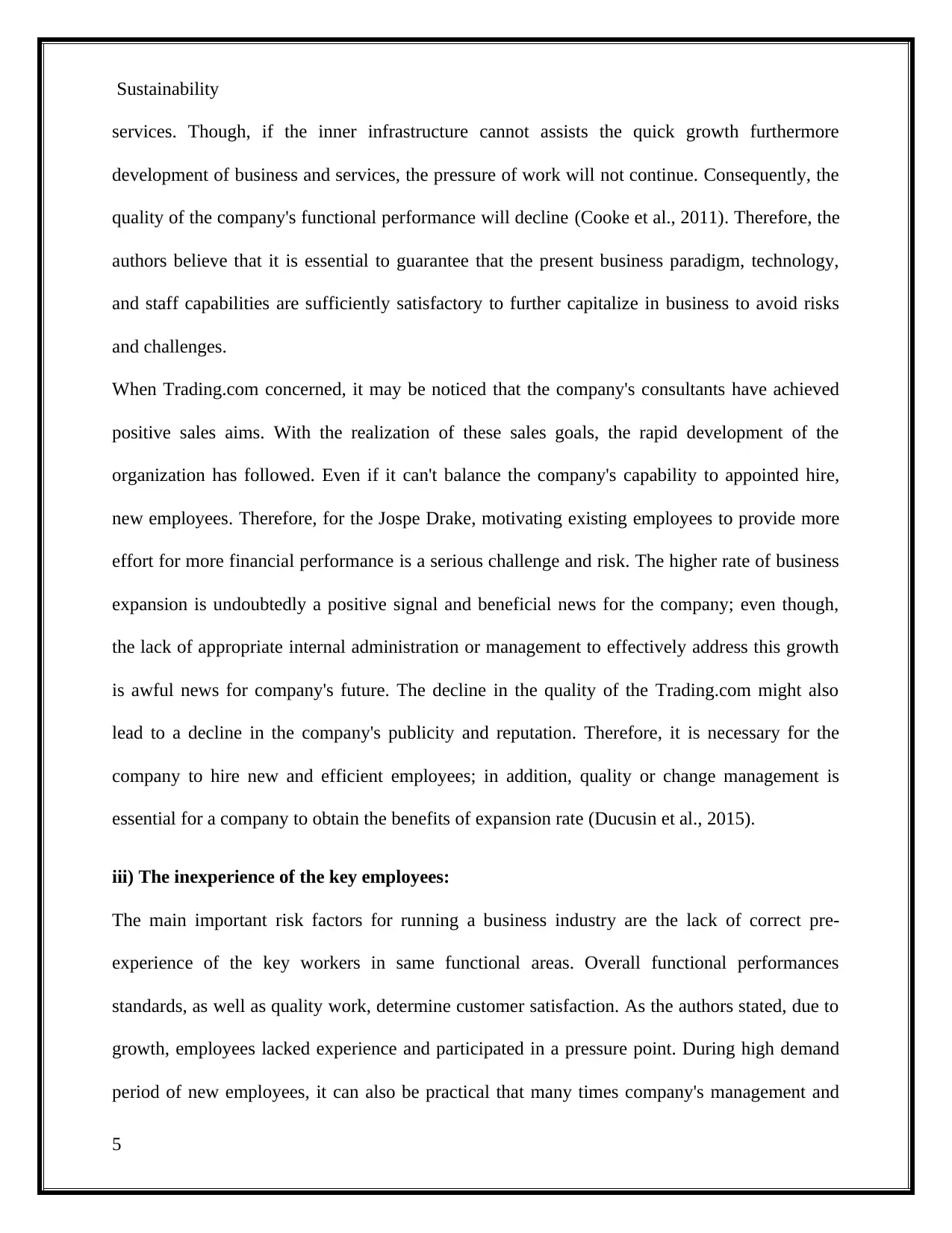
Sustainability
services. Though, if the inner infrastructure cannot assists the quick growth furthermore
development of business and services, the pressure of work will not continue. Consequently, the
quality of the company's functional performance will decline (Cooke et al., 2011). Therefore, the
authors believe that it is essential to guarantee that the present business paradigm, technology,
and staff capabilities are sufficiently satisfactory to further capitalize in business to avoid risks
and challenges.
When Trading.com concerned, it may be noticed that the company's consultants have achieved
positive sales aims. With the realization of these sales goals, the rapid development of the
organization has followed. Even if it can't balance the company's capability to appointed hire,
new employees. Therefore, for the Jospe Drake, motivating existing employees to provide more
effort for more financial performance is a serious challenge and risk. The higher rate of business
expansion is undoubtedly a positive signal and beneficial news for the company; even though,
the lack of appropriate internal administration or management to effectively address this growth
is awful news for company's future. The decline in the quality of the Trading.com might also
lead to a decline in the company's publicity and reputation. Therefore, it is necessary for the
company to hire new and efficient employees; in addition, quality or change management is
essential for a company to obtain the benefits of expansion rate (Ducusin et al., 2015).
iii) The inexperience of the key employees:
The main important risk factors for running a business industry are the lack of correct pre-
experience of the key workers in same functional areas. Overall functional performances
standards, as well as quality work, determine customer satisfaction. As the authors stated, due to
growth, employees lacked experience and participated in a pressure point. During high demand
period of new employees, it can also be practical that many times company's management and
5
services. Though, if the inner infrastructure cannot assists the quick growth furthermore
development of business and services, the pressure of work will not continue. Consequently, the
quality of the company's functional performance will decline (Cooke et al., 2011). Therefore, the
authors believe that it is essential to guarantee that the present business paradigm, technology,
and staff capabilities are sufficiently satisfactory to further capitalize in business to avoid risks
and challenges.
When Trading.com concerned, it may be noticed that the company's consultants have achieved
positive sales aims. With the realization of these sales goals, the rapid development of the
organization has followed. Even if it can't balance the company's capability to appointed hire,
new employees. Therefore, for the Jospe Drake, motivating existing employees to provide more
effort for more financial performance is a serious challenge and risk. The higher rate of business
expansion is undoubtedly a positive signal and beneficial news for the company; even though,
the lack of appropriate internal administration or management to effectively address this growth
is awful news for company's future. The decline in the quality of the Trading.com might also
lead to a decline in the company's publicity and reputation. Therefore, it is necessary for the
company to hire new and efficient employees; in addition, quality or change management is
essential for a company to obtain the benefits of expansion rate (Ducusin et al., 2015).
iii) The inexperience of the key employees:
The main important risk factors for running a business industry are the lack of correct pre-
experience of the key workers in same functional areas. Overall functional performances
standards, as well as quality work, determine customer satisfaction. As the authors stated, due to
growth, employees lacked experience and participated in a pressure point. During high demand
period of new employees, it can also be practical that many times company's management and
5
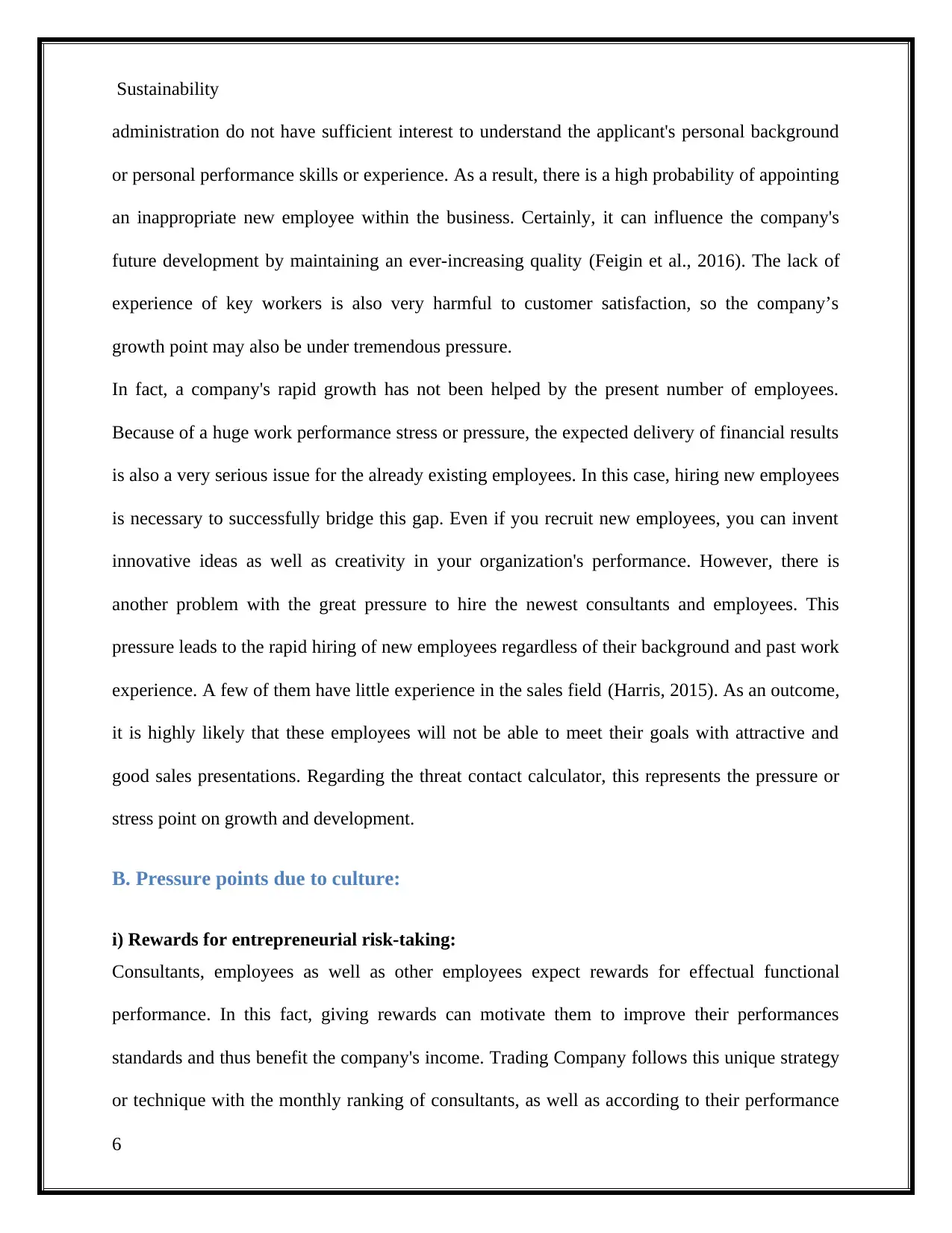
Sustainability
administration do not have sufficient interest to understand the applicant's personal background
or personal performance skills or experience. As a result, there is a high probability of appointing
an inappropriate new employee within the business. Certainly, it can influence the company's
future development by maintaining an ever-increasing quality (Feigin et al., 2016). The lack of
experience of key workers is also very harmful to customer satisfaction, so the company’s
growth point may also be under tremendous pressure.
In fact, a company's rapid growth has not been helped by the present number of employees.
Because of a huge work performance stress or pressure, the expected delivery of financial results
is also a very serious issue for the already existing employees. In this case, hiring new employees
is necessary to successfully bridge this gap. Even if you recruit new employees, you can invent
innovative ideas as well as creativity in your organization's performance. However, there is
another problem with the great pressure to hire the newest consultants and employees. This
pressure leads to the rapid hiring of new employees regardless of their background and past work
experience. A few of them have little experience in the sales field (Harris, 2015). As an outcome,
it is highly likely that these employees will not be able to meet their goals with attractive and
good sales presentations. Regarding the threat contact calculator, this represents the pressure or
stress point on growth and development.
B. Pressure points due to culture:
i) Rewards for entrepreneurial risk-taking:
Consultants, employees as well as other employees expect rewards for effectual functional
performance. In this fact, giving rewards can motivate them to improve their performances
standards and thus benefit the company's income. Trading Company follows this unique strategy
or technique with the monthly ranking of consultants, as well as according to their performance
6
administration do not have sufficient interest to understand the applicant's personal background
or personal performance skills or experience. As a result, there is a high probability of appointing
an inappropriate new employee within the business. Certainly, it can influence the company's
future development by maintaining an ever-increasing quality (Feigin et al., 2016). The lack of
experience of key workers is also very harmful to customer satisfaction, so the company’s
growth point may also be under tremendous pressure.
In fact, a company's rapid growth has not been helped by the present number of employees.
Because of a huge work performance stress or pressure, the expected delivery of financial results
is also a very serious issue for the already existing employees. In this case, hiring new employees
is necessary to successfully bridge this gap. Even if you recruit new employees, you can invent
innovative ideas as well as creativity in your organization's performance. However, there is
another problem with the great pressure to hire the newest consultants and employees. This
pressure leads to the rapid hiring of new employees regardless of their background and past work
experience. A few of them have little experience in the sales field (Harris, 2015). As an outcome,
it is highly likely that these employees will not be able to meet their goals with attractive and
good sales presentations. Regarding the threat contact calculator, this represents the pressure or
stress point on growth and development.
B. Pressure points due to culture:
i) Rewards for entrepreneurial risk-taking:
Consultants, employees as well as other employees expect rewards for effectual functional
performance. In this fact, giving rewards can motivate them to improve their performances
standards and thus benefit the company's income. Trading Company follows this unique strategy
or technique with the monthly ranking of consultants, as well as according to their performance
6
⊘ This is a preview!⊘
Do you want full access?
Subscribe today to unlock all pages.

Trusted by 1+ million students worldwide
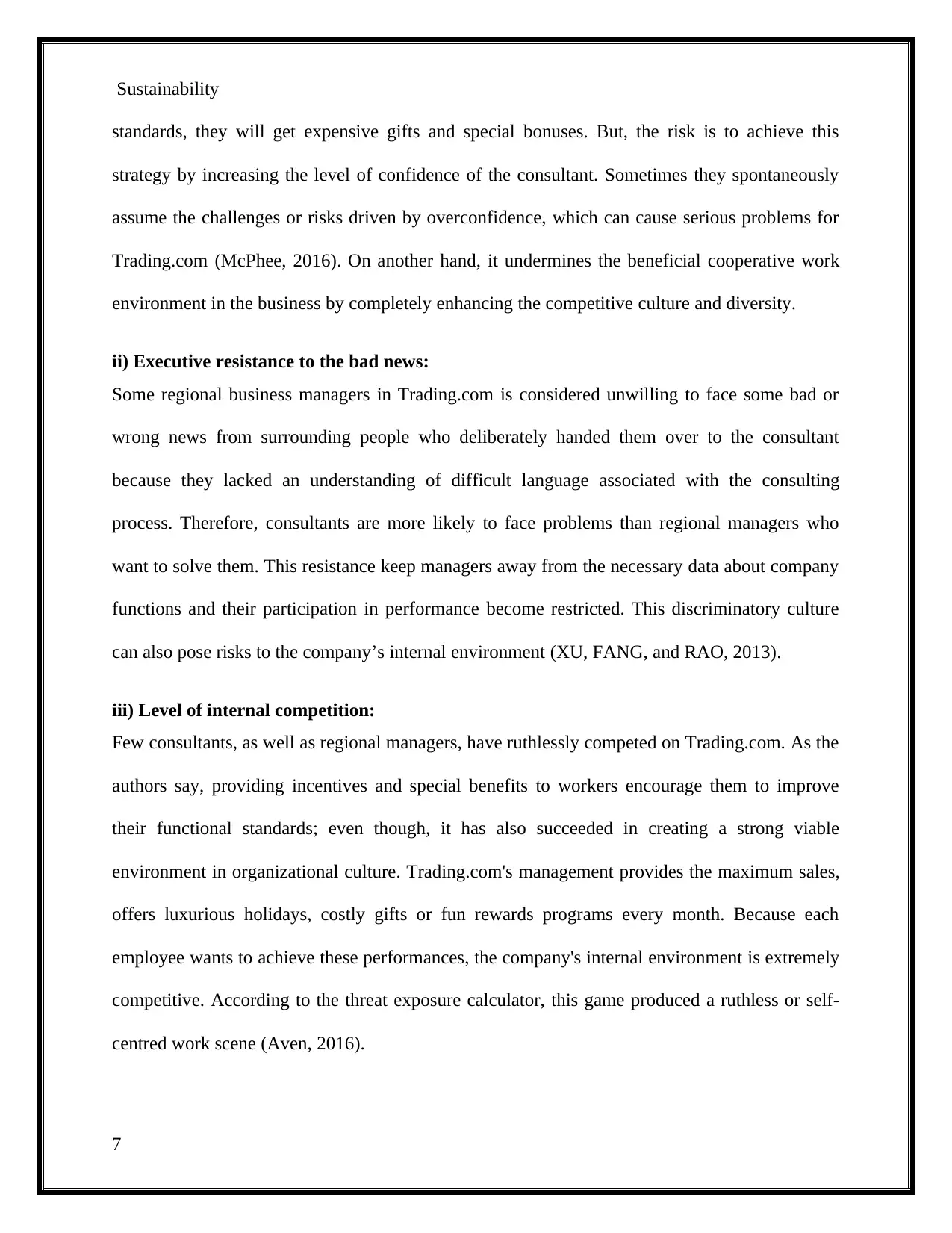
Sustainability
standards, they will get expensive gifts and special bonuses. But, the risk is to achieve this
strategy by increasing the level of confidence of the consultant. Sometimes they spontaneously
assume the challenges or risks driven by overconfidence, which can cause serious problems for
Trading.com (McPhee, 2016). On another hand, it undermines the beneficial cooperative work
environment in the business by completely enhancing the competitive culture and diversity.
ii) Executive resistance to the bad news:
Some regional business managers in Trading.com is considered unwilling to face some bad or
wrong news from surrounding people who deliberately handed them over to the consultant
because they lacked an understanding of difficult language associated with the consulting
process. Therefore, consultants are more likely to face problems than regional managers who
want to solve them. This resistance keep managers away from the necessary data about company
functions and their participation in performance become restricted. This discriminatory culture
can also pose risks to the company’s internal environment (XU, FANG, and RAO, 2013).
iii) Level of internal competition:
Few consultants, as well as regional managers, have ruthlessly competed on Trading.com. As the
authors say, providing incentives and special benefits to workers encourage them to improve
their functional standards; even though, it has also succeeded in creating a strong viable
environment in organizational culture. Trading.com's management provides the maximum sales,
offers luxurious holidays, costly gifts or fun rewards programs every month. Because each
employee wants to achieve these performances, the company's internal environment is extremely
competitive. According to the threat exposure calculator, this game produced a ruthless or self-
centred work scene (Aven, 2016).
7
standards, they will get expensive gifts and special bonuses. But, the risk is to achieve this
strategy by increasing the level of confidence of the consultant. Sometimes they spontaneously
assume the challenges or risks driven by overconfidence, which can cause serious problems for
Trading.com (McPhee, 2016). On another hand, it undermines the beneficial cooperative work
environment in the business by completely enhancing the competitive culture and diversity.
ii) Executive resistance to the bad news:
Some regional business managers in Trading.com is considered unwilling to face some bad or
wrong news from surrounding people who deliberately handed them over to the consultant
because they lacked an understanding of difficult language associated with the consulting
process. Therefore, consultants are more likely to face problems than regional managers who
want to solve them. This resistance keep managers away from the necessary data about company
functions and their participation in performance become restricted. This discriminatory culture
can also pose risks to the company’s internal environment (XU, FANG, and RAO, 2013).
iii) Level of internal competition:
Few consultants, as well as regional managers, have ruthlessly competed on Trading.com. As the
authors say, providing incentives and special benefits to workers encourage them to improve
their functional standards; even though, it has also succeeded in creating a strong viable
environment in organizational culture. Trading.com's management provides the maximum sales,
offers luxurious holidays, costly gifts or fun rewards programs every month. Because each
employee wants to achieve these performances, the company's internal environment is extremely
competitive. According to the threat exposure calculator, this game produced a ruthless or self-
centred work scene (Aven, 2016).
7
Paraphrase This Document
Need a fresh take? Get an instant paraphrase of this document with our AI Paraphraser
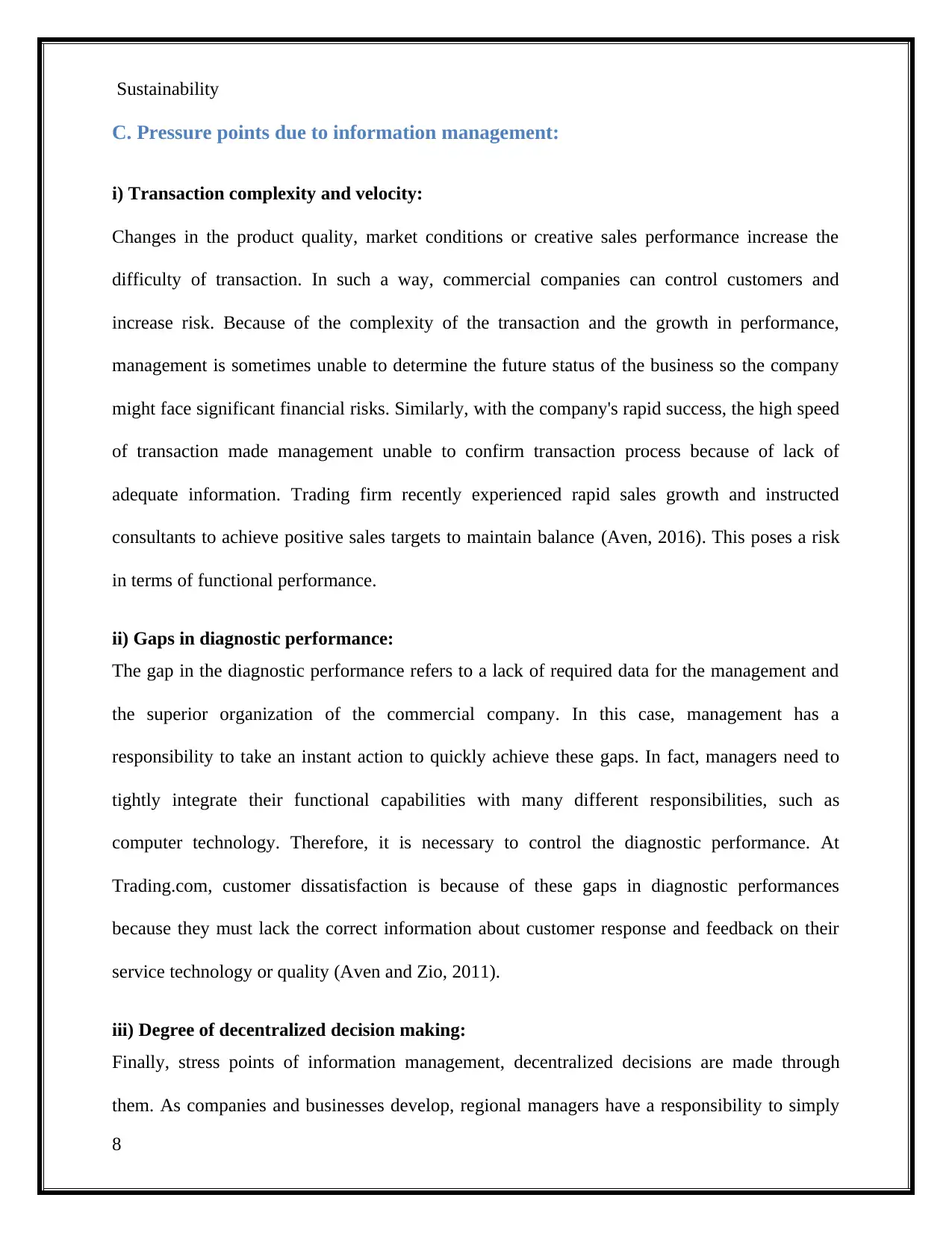
Sustainability
C. Pressure points due to information management:
i) Transaction complexity and velocity:
Changes in the product quality, market conditions or creative sales performance increase the
difficulty of transaction. In such a way, commercial companies can control customers and
increase risk. Because of the complexity of the transaction and the growth in performance,
management is sometimes unable to determine the future status of the business so the company
might face significant financial risks. Similarly, with the company's rapid success, the high speed
of transaction made management unable to confirm transaction process because of lack of
adequate information. Trading firm recently experienced rapid sales growth and instructed
consultants to achieve positive sales targets to maintain balance (Aven, 2016). This poses a risk
in terms of functional performance.
ii) Gaps in diagnostic performance:
The gap in the diagnostic performance refers to a lack of required data for the management and
the superior organization of the commercial company. In this case, management has a
responsibility to take an instant action to quickly achieve these gaps. In fact, managers need to
tightly integrate their functional capabilities with many different responsibilities, such as
computer technology. Therefore, it is necessary to control the diagnostic performance. At
Trading.com, customer dissatisfaction is because of these gaps in diagnostic performances
because they must lack the correct information about customer response and feedback on their
service technology or quality (Aven and Zio, 2011).
iii) Degree of decentralized decision making:
Finally, stress points of information management, decentralized decisions are made through
them. As companies and businesses develop, regional managers have a responsibility to simply
8
C. Pressure points due to information management:
i) Transaction complexity and velocity:
Changes in the product quality, market conditions or creative sales performance increase the
difficulty of transaction. In such a way, commercial companies can control customers and
increase risk. Because of the complexity of the transaction and the growth in performance,
management is sometimes unable to determine the future status of the business so the company
might face significant financial risks. Similarly, with the company's rapid success, the high speed
of transaction made management unable to confirm transaction process because of lack of
adequate information. Trading firm recently experienced rapid sales growth and instructed
consultants to achieve positive sales targets to maintain balance (Aven, 2016). This poses a risk
in terms of functional performance.
ii) Gaps in diagnostic performance:
The gap in the diagnostic performance refers to a lack of required data for the management and
the superior organization of the commercial company. In this case, management has a
responsibility to take an instant action to quickly achieve these gaps. In fact, managers need to
tightly integrate their functional capabilities with many different responsibilities, such as
computer technology. Therefore, it is necessary to control the diagnostic performance. At
Trading.com, customer dissatisfaction is because of these gaps in diagnostic performances
because they must lack the correct information about customer response and feedback on their
service technology or quality (Aven and Zio, 2011).
iii) Degree of decentralized decision making:
Finally, stress points of information management, decentralized decisions are made through
them. As companies and businesses develop, regional managers have a responsibility to simply
8
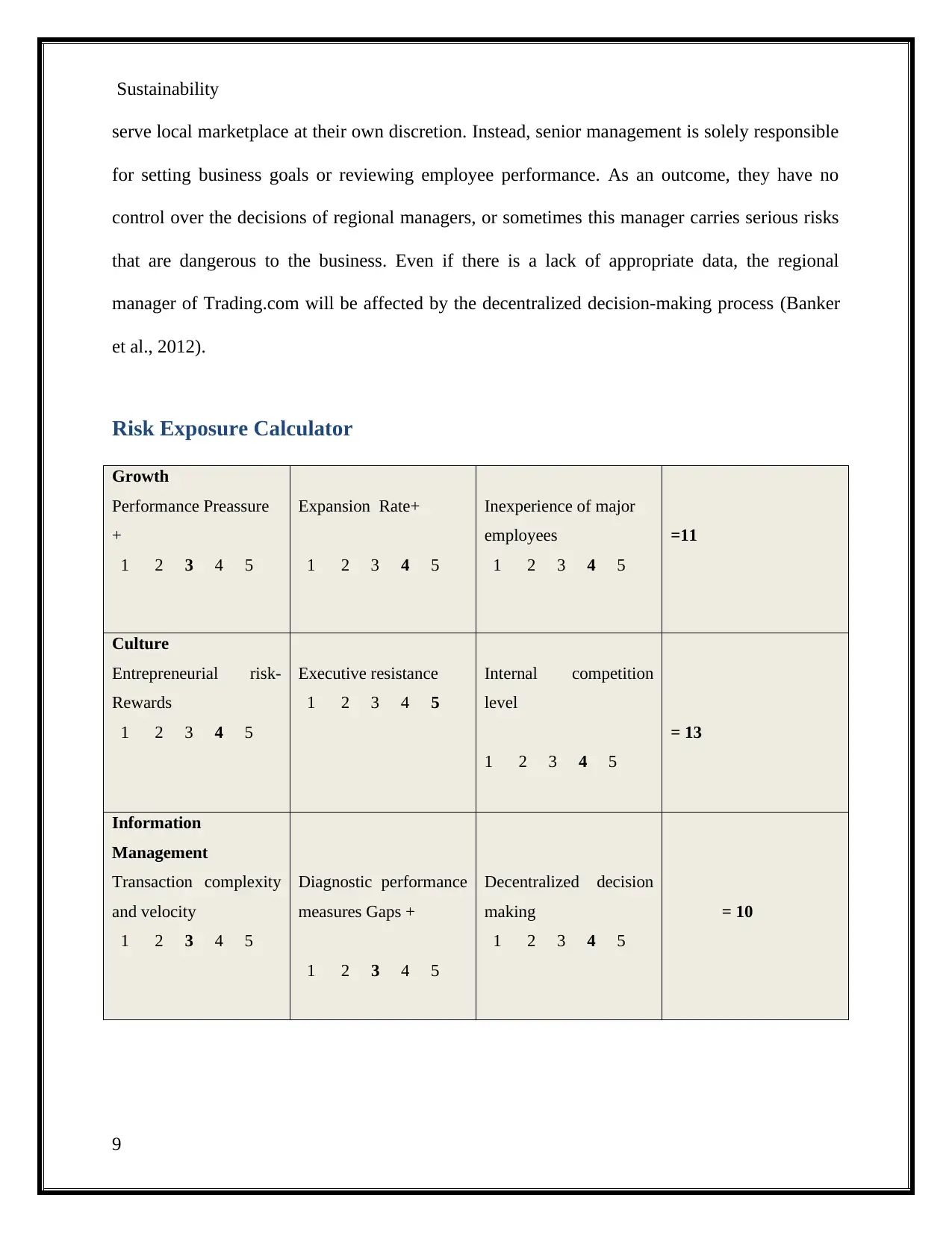
Sustainability
serve local marketplace at their own discretion. Instead, senior management is solely responsible
for setting business goals or reviewing employee performance. As an outcome, they have no
control over the decisions of regional managers, or sometimes this manager carries serious risks
that are dangerous to the business. Even if there is a lack of appropriate data, the regional
manager of Trading.com will be affected by the decentralized decision-making process (Banker
et al., 2012).
Risk Exposure Calculator
Growth
Performance Preassure
+
1 2 3 4 5
Expansion Rate+
1 2 3 4 5
Inexperience of major
employees
1 2 3 4 5
=11
Culture
Entrepreneurial risk-
Rewards
1 2 3 4 5
Executive resistance
1 2 3 4 5
Internal competition
level
1 2 3 4 5
= 13
Information
Management
Transaction complexity
and velocity
1 2 3 4 5
Diagnostic performance
measures Gaps +
1 2 3 4 5
Decentralized decision
making
1 2 3 4 5
= 10
9
serve local marketplace at their own discretion. Instead, senior management is solely responsible
for setting business goals or reviewing employee performance. As an outcome, they have no
control over the decisions of regional managers, or sometimes this manager carries serious risks
that are dangerous to the business. Even if there is a lack of appropriate data, the regional
manager of Trading.com will be affected by the decentralized decision-making process (Banker
et al., 2012).
Risk Exposure Calculator
Growth
Performance Preassure
+
1 2 3 4 5
Expansion Rate+
1 2 3 4 5
Inexperience of major
employees
1 2 3 4 5
=11
Culture
Entrepreneurial risk-
Rewards
1 2 3 4 5
Executive resistance
1 2 3 4 5
Internal competition
level
1 2 3 4 5
= 13
Information
Management
Transaction complexity
and velocity
1 2 3 4 5
Diagnostic performance
measures Gaps +
1 2 3 4 5
Decentralized decision
making
1 2 3 4 5
= 10
9
⊘ This is a preview!⊘
Do you want full access?
Subscribe today to unlock all pages.

Trusted by 1+ million students worldwide
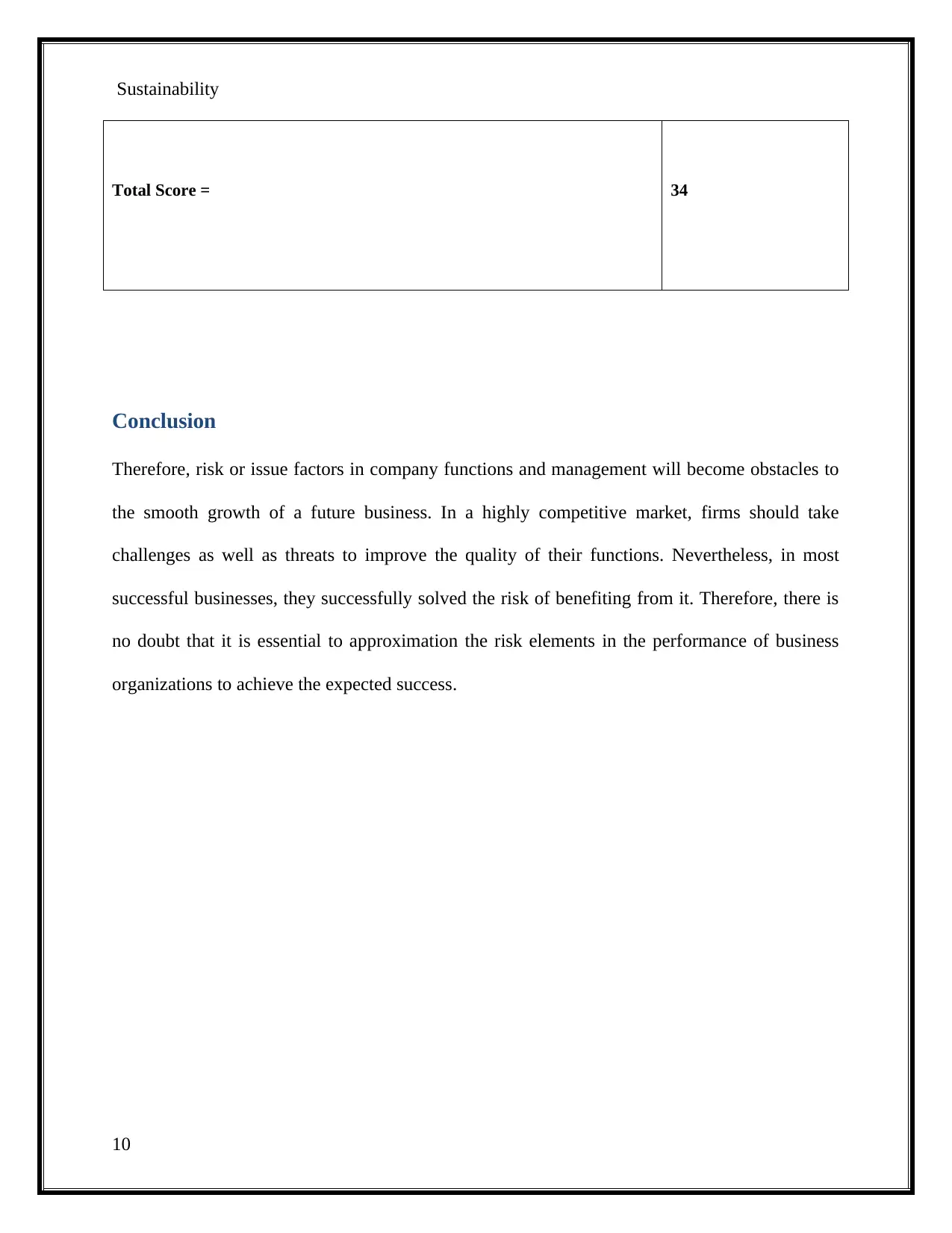
Sustainability
Total Score = 34
Conclusion
Therefore, risk or issue factors in company functions and management will become obstacles to
the smooth growth of a future business. In a highly competitive market, firms should take
challenges as well as threats to improve the quality of their functions. Nevertheless, in most
successful businesses, they successfully solved the risk of benefiting from it. Therefore, there is
no doubt that it is essential to approximation the risk elements in the performance of business
organizations to achieve the expected success.
10
Total Score = 34
Conclusion
Therefore, risk or issue factors in company functions and management will become obstacles to
the smooth growth of a future business. In a highly competitive market, firms should take
challenges as well as threats to improve the quality of their functions. Nevertheless, in most
successful businesses, they successfully solved the risk of benefiting from it. Therefore, there is
no doubt that it is essential to approximation the risk elements in the performance of business
organizations to achieve the expected success.
10
Paraphrase This Document
Need a fresh take? Get an instant paraphrase of this document with our AI Paraphraser
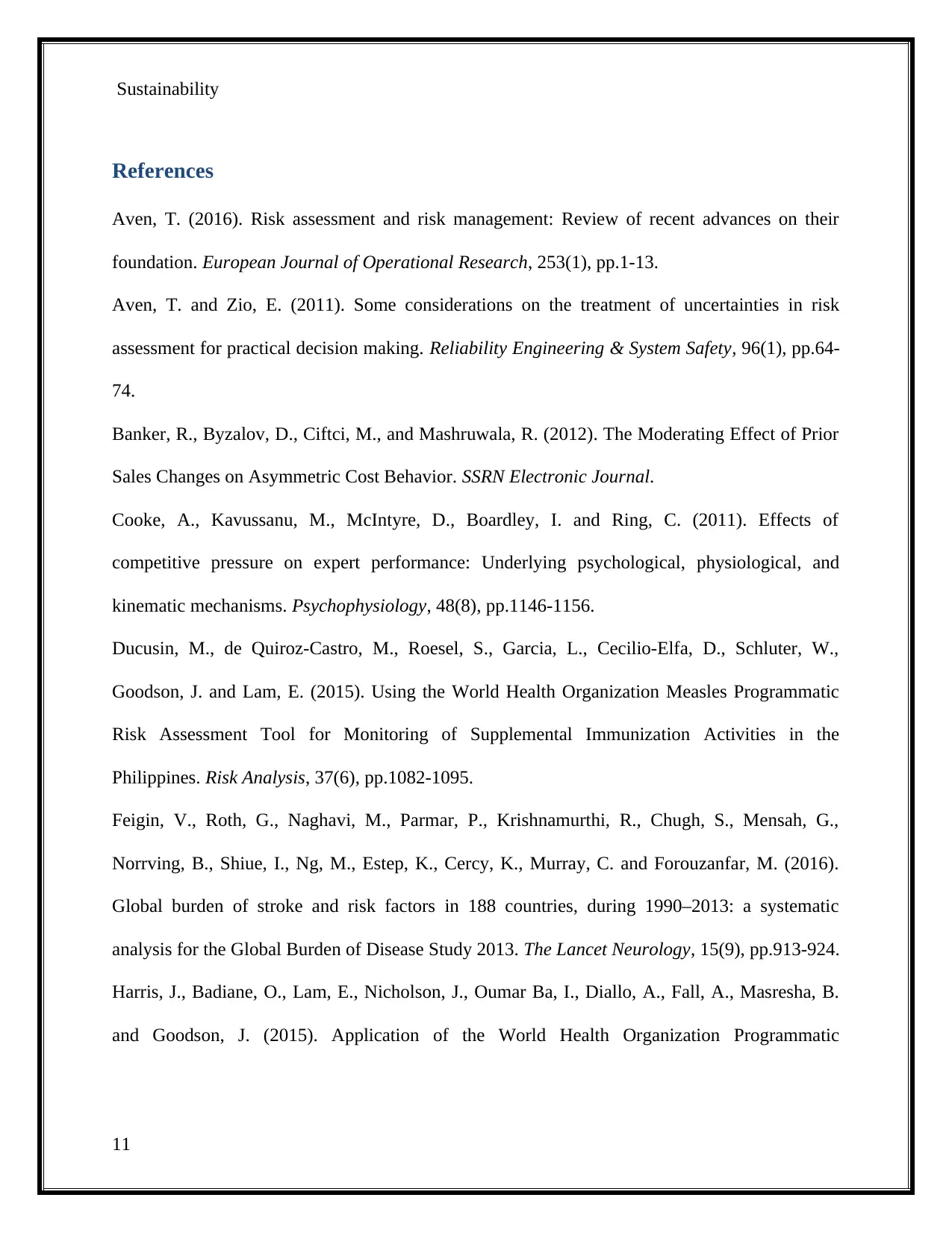
Sustainability
References
Aven, T. (2016). Risk assessment and risk management: Review of recent advances on their
foundation. European Journal of Operational Research, 253(1), pp.1-13.
Aven, T. and Zio, E. (2011). Some considerations on the treatment of uncertainties in risk
assessment for practical decision making. Reliability Engineering & System Safety, 96(1), pp.64-
74.
Banker, R., Byzalov, D., Ciftci, M., and Mashruwala, R. (2012). The Moderating Effect of Prior
Sales Changes on Asymmetric Cost Behavior. SSRN Electronic Journal.
Cooke, A., Kavussanu, M., McIntyre, D., Boardley, I. and Ring, C. (2011). Effects of
competitive pressure on expert performance: Underlying psychological, physiological, and
kinematic mechanisms. Psychophysiology, 48(8), pp.1146-1156.
Ducusin, M., de Quiroz-Castro, M., Roesel, S., Garcia, L., Cecilio-Elfa, D., Schluter, W.,
Goodson, J. and Lam, E. (2015). Using the World Health Organization Measles Programmatic
Risk Assessment Tool for Monitoring of Supplemental Immunization Activities in the
Philippines. Risk Analysis, 37(6), pp.1082-1095.
Feigin, V., Roth, G., Naghavi, M., Parmar, P., Krishnamurthi, R., Chugh, S., Mensah, G.,
Norrving, B., Shiue, I., Ng, M., Estep, K., Cercy, K., Murray, C. and Forouzanfar, M. (2016).
Global burden of stroke and risk factors in 188 countries, during 1990–2013: a systematic
analysis for the Global Burden of Disease Study 2013. The Lancet Neurology, 15(9), pp.913-924.
Harris, J., Badiane, O., Lam, E., Nicholson, J., Oumar Ba, I., Diallo, A., Fall, A., Masresha, B.
and Goodson, J. (2015). Application of the World Health Organization Programmatic
11
References
Aven, T. (2016). Risk assessment and risk management: Review of recent advances on their
foundation. European Journal of Operational Research, 253(1), pp.1-13.
Aven, T. and Zio, E. (2011). Some considerations on the treatment of uncertainties in risk
assessment for practical decision making. Reliability Engineering & System Safety, 96(1), pp.64-
74.
Banker, R., Byzalov, D., Ciftci, M., and Mashruwala, R. (2012). The Moderating Effect of Prior
Sales Changes on Asymmetric Cost Behavior. SSRN Electronic Journal.
Cooke, A., Kavussanu, M., McIntyre, D., Boardley, I. and Ring, C. (2011). Effects of
competitive pressure on expert performance: Underlying psychological, physiological, and
kinematic mechanisms. Psychophysiology, 48(8), pp.1146-1156.
Ducusin, M., de Quiroz-Castro, M., Roesel, S., Garcia, L., Cecilio-Elfa, D., Schluter, W.,
Goodson, J. and Lam, E. (2015). Using the World Health Organization Measles Programmatic
Risk Assessment Tool for Monitoring of Supplemental Immunization Activities in the
Philippines. Risk Analysis, 37(6), pp.1082-1095.
Feigin, V., Roth, G., Naghavi, M., Parmar, P., Krishnamurthi, R., Chugh, S., Mensah, G.,
Norrving, B., Shiue, I., Ng, M., Estep, K., Cercy, K., Murray, C. and Forouzanfar, M. (2016).
Global burden of stroke and risk factors in 188 countries, during 1990–2013: a systematic
analysis for the Global Burden of Disease Study 2013. The Lancet Neurology, 15(9), pp.913-924.
Harris, J., Badiane, O., Lam, E., Nicholson, J., Oumar Ba, I., Diallo, A., Fall, A., Masresha, B.
and Goodson, J. (2015). Application of the World Health Organization Programmatic
11
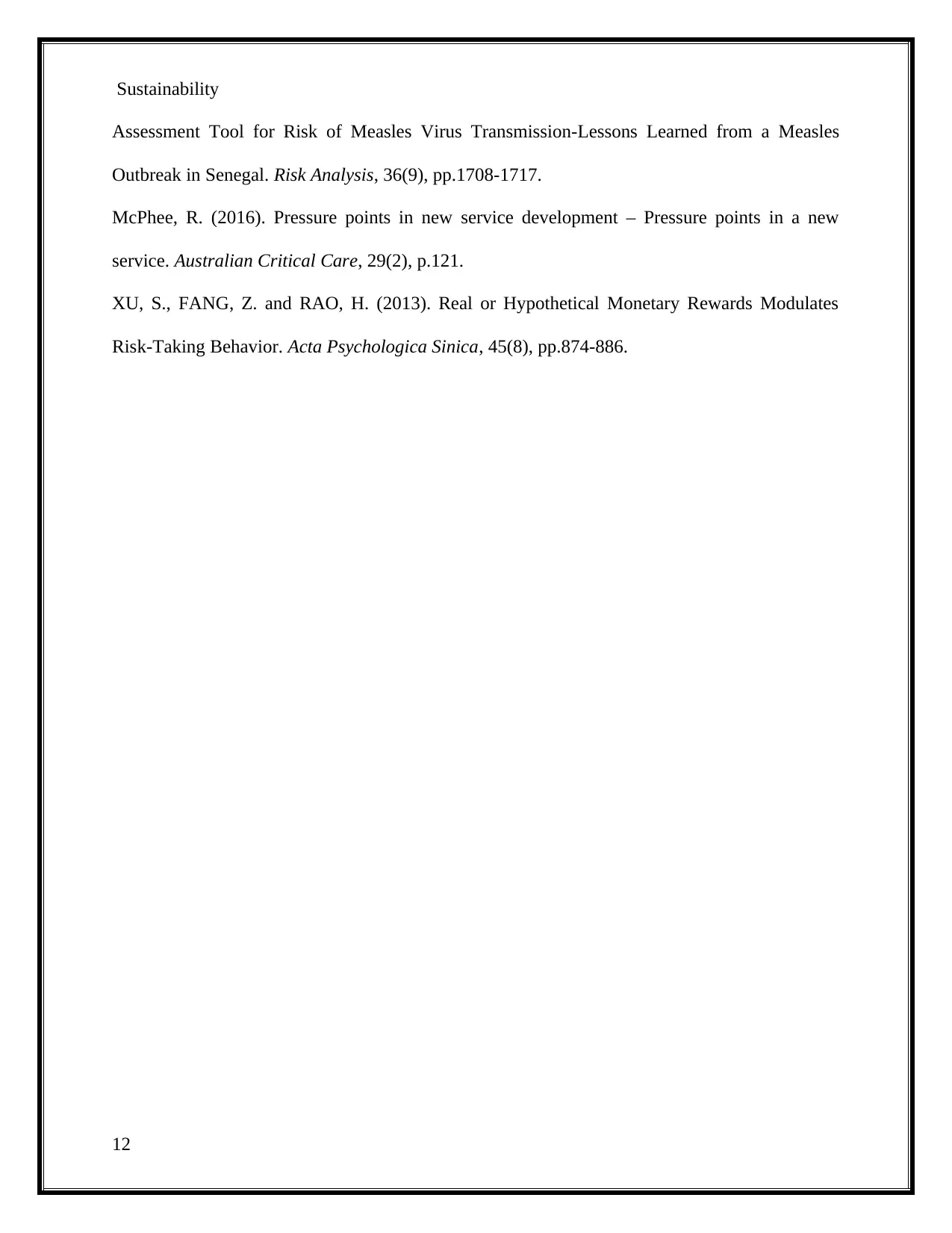
Sustainability
Assessment Tool for Risk of Measles Virus Transmission-Lessons Learned from a Measles
Outbreak in Senegal. Risk Analysis, 36(9), pp.1708-1717.
McPhee, R. (2016). Pressure points in new service development – Pressure points in a new
service. Australian Critical Care, 29(2), p.121.
XU, S., FANG, Z. and RAO, H. (2013). Real or Hypothetical Monetary Rewards Modulates
Risk-Taking Behavior. Acta Psychologica Sinica, 45(8), pp.874-886.
12
Assessment Tool for Risk of Measles Virus Transmission-Lessons Learned from a Measles
Outbreak in Senegal. Risk Analysis, 36(9), pp.1708-1717.
McPhee, R. (2016). Pressure points in new service development – Pressure points in a new
service. Australian Critical Care, 29(2), p.121.
XU, S., FANG, Z. and RAO, H. (2013). Real or Hypothetical Monetary Rewards Modulates
Risk-Taking Behavior. Acta Psychologica Sinica, 45(8), pp.874-886.
12
⊘ This is a preview!⊘
Do you want full access?
Subscribe today to unlock all pages.

Trusted by 1+ million students worldwide
1 out of 12
Related Documents
Your All-in-One AI-Powered Toolkit for Academic Success.
+13062052269
info@desklib.com
Available 24*7 on WhatsApp / Email
![[object Object]](/_next/static/media/star-bottom.7253800d.svg)
Unlock your academic potential
Copyright © 2020–2025 A2Z Services. All Rights Reserved. Developed and managed by ZUCOL.


